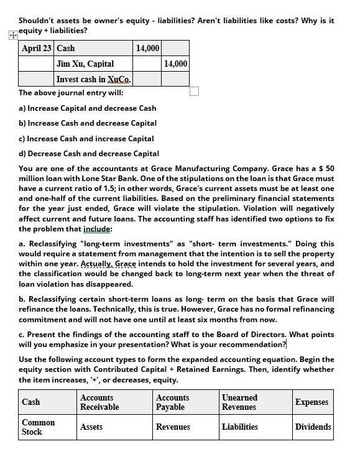
FINANCIAL ACCOUNTING
10th Edition
ISBN: 9781259964947
Author: Libby
Publisher: MCG
expand_more
expand_more
format_list_bulleted
Question
None

Transcribed Image Text:Shouldn't assets be owner's equity - liabilities? Aren't liabilities like costs? Why is it
equity+ liabilities?
April 23 Cash
Jim Xu, Capital
Invest cash in XuCo.
The above journal entry will:
14,000
14,000
a) Increase Capital and decrease Cash
b) Increase Cash and decrease Capital
c) Increase Cash and increase Capital
d) Decrease Cash and decrease Capital
You are one of the accountants at Grace Manufacturing Company. Grace has a $ 50
million loan with Lone Star Bank. One of the stipulations on the loan is that Grace must
have a current ratio of 1.5; in other words, Grace's current assets must be at least one
and one-half of the current liabilities. Based on the preliminary financial statements
for the year just ended, Grace will violate the stipulation. Violation will negatively
affect current and future loans. The accounting staff has identified two options to fix
the problem that include:
a. Reclassifying "long-term investments" as "short-term investments." Doing this
would require a statement from management that the intention is to sell the property
within one year. Actually, Grace intends to hold the investment for several years, and
the classification would be changed back to long-term next year when the threat of
loan violation has disappeared.
b. Reclassifying certain short-term loans as long-term on the basis that Grace will
refinance the loans. Technically, this is true. However, Grace has no formal refinancing
commitment and will not have one until at least six months from now.
c. Present the findings of the accounting staff to the Board of Directors. What points
will you emphasize in your presentation? What is your recommendation?
Use the following account types to form the expanded accounting equation. Begin the
equity section with Contributed Capital + Retained Earnings. Then, identify whether
the item increases, '+', or decreases, equity.
Cash
Accounts
Receivable
Common
Stock
Assets
Accounts
Payable
Unearned
Revenues
Expenses
Revenues
Liabilities
Dividends
Expert Solution
This question has been solved!
Explore an expertly crafted, step-by-step solution for a thorough understanding of key concepts.
Step by stepSolved in 2 steps

Knowledge Booster
Similar questions
arrow_back_ios
arrow_forward_ios
Recommended textbooks for you

 AccountingAccountingISBN:9781337272094Author:WARREN, Carl S., Reeve, James M., Duchac, Jonathan E.Publisher:Cengage Learning,
AccountingAccountingISBN:9781337272094Author:WARREN, Carl S., Reeve, James M., Duchac, Jonathan E.Publisher:Cengage Learning, Accounting Information SystemsAccountingISBN:9781337619202Author:Hall, James A.Publisher:Cengage Learning,
Accounting Information SystemsAccountingISBN:9781337619202Author:Hall, James A.Publisher:Cengage Learning, Horngren's Cost Accounting: A Managerial Emphasis...AccountingISBN:9780134475585Author:Srikant M. Datar, Madhav V. RajanPublisher:PEARSON
Horngren's Cost Accounting: A Managerial Emphasis...AccountingISBN:9780134475585Author:Srikant M. Datar, Madhav V. RajanPublisher:PEARSON Intermediate AccountingAccountingISBN:9781259722660Author:J. David Spiceland, Mark W. Nelson, Wayne M ThomasPublisher:McGraw-Hill Education
Intermediate AccountingAccountingISBN:9781259722660Author:J. David Spiceland, Mark W. Nelson, Wayne M ThomasPublisher:McGraw-Hill Education Financial and Managerial AccountingAccountingISBN:9781259726705Author:John J Wild, Ken W. Shaw, Barbara Chiappetta Fundamental Accounting PrinciplesPublisher:McGraw-Hill Education
Financial and Managerial AccountingAccountingISBN:9781259726705Author:John J Wild, Ken W. Shaw, Barbara Chiappetta Fundamental Accounting PrinciplesPublisher:McGraw-Hill Education


Accounting
Accounting
ISBN:9781337272094
Author:WARREN, Carl S., Reeve, James M., Duchac, Jonathan E.
Publisher:Cengage Learning,

Accounting Information Systems
Accounting
ISBN:9781337619202
Author:Hall, James A.
Publisher:Cengage Learning,

Horngren's Cost Accounting: A Managerial Emphasis...
Accounting
ISBN:9780134475585
Author:Srikant M. Datar, Madhav V. Rajan
Publisher:PEARSON

Intermediate Accounting
Accounting
ISBN:9781259722660
Author:J. David Spiceland, Mark W. Nelson, Wayne M Thomas
Publisher:McGraw-Hill Education

Financial and Managerial Accounting
Accounting
ISBN:9781259726705
Author:John J Wild, Ken W. Shaw, Barbara Chiappetta Fundamental Accounting Principles
Publisher:McGraw-Hill Education